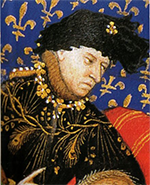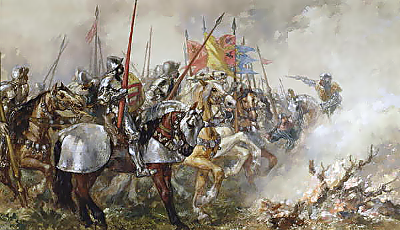The French King Charles VI
Charles VI was King of France in the late 14th and early 15th Centuries, while his country was fighting the Hundred Years War with England. Prone to fits of violent ill health, he was known as Charles the Mad. He was born on Dec. 13, 1368, in Paris. His father was at the time the reigning monarch, Charles V. That king died in 1380, and the young Charles took the throne; he was 11. Dominating his regency were the Council of 12, an advisory body headed by Philip the Bold of Burgundy. The nobles, dukes mostly, squabbled among themselves and spent large parts of the considerable treasury that Charles V had built up on pet projects. Charles VI married Isabeau of Bavaria in 1385. She spoke no French, he spoke no German, and they had an unhappy marriage; despite this, they had 12 children together. The king dismissed the Council of 12 in 1388 and ruled in his own name, restoring to power the Marmousets, trusted advisors of his father; for a time, the fortunes of the country improved. The following year, Charles encouraged Clement VII, named pope in Avignon (as part of the Avignon Papacy, a rival line of pontiffs begun by King Philip IV), to declare himself pope in Rome. France was still fighting the Hundred Years War at this time, and the English king, Richard II, favored a different pontiff, Boniface IX, who had been so proclaimed in Rome; the two monarchs engaged in discussions along those lines and also in the area of ending the war. 
These peace discussions dragged on. In 1392, Charles, while hunting, suffered a fever and convulsions; mysteriously, his hair and nails fell out. He suffered similiar attacks on more than 40 other occasions, throughout the rest of his life. In one period of considerable mental stress, the king thought himself made of glass; fearing that he would break, he wore protective clothing and refused to bathe, as a result suffering a handful of skin maladies. Another time, he did not know his identity or his station and failed to recognize his wife or children. Violent behavior often accompanied these attacks, which themselves sometimes lasted for a few months. On one occasion, Charles, seized with a sudden fit of madness, killed four of his own retinue. He agreed to some questionable efforts to relieve his sufferings, including letting a surgeon drill holes in his head (as a way to lessen what was thought to be swelling on the brain) and allowing religious officials to perform an exorcism (in order to get rid of an assumed evil spirit). Modern interpretations of the king's illness range from paranoia and schizophrenia to encephalitis and porphyria (which many historians also think afflicted England's King George III). French nobles took the initiative in continuing peace negotiations with England, and the two countries signed a truce in 1396 that was designed to last 28 years. As part of the pact, Charles agreed to give his daughter, 6-year-old Isabelle, in marriage to Richard II. When Richard died in 1400, the new English monarch, Henry IV, wanted the still young Isabella to marry the 14-year-old heir to the English throne, also named Henry. Charles and Isabella refused. The young Henry did later marry a daughter of Charles and Isabeau, Catherine of Valois; this occurred in 1420, as a result of the Treaty of Troyes, which also designated Henry as the heir to the French throne. French forces embarked on a war with Burgundy in 1407; this war lasted for another 28 years. The war with England flared up again in 1415, when Henry V landed on French shores with a force of 12,000 men and 20,000 horses. The initial destination was Harfleur, and the English siege of that port town was eventually successful–but not before an illness had ripped through the victorious army, depleting it by several thousand. 
Henry pressed on toward Calais, but he didn't get there before encountering a French army 20,000 strong. The result was the Battle of Agincourt, which occurred on Oct 25, 1415. In a somewhat repeat performance of what happened at Crécy in 1346, the English again had far fewer forces but again overcame those odds in extraordinary fashion. Henry V himself led the fighting. English and Welsh longbows, nearly 80 percent of the English force, cut down the first French charge, the second got bogged down in the mud, and the third didn't have the heart to trudge through so many French dead and fled the field. Henry capitalized on his stunning victory by retaking Normandy. The tide of the war had turned again, in the favor of England. Charles VI died on Oct. 21, 1422. Henry V had died two months previously According to the terms of the Treaty of Troyes, the son of Henry V and Catherine–at the time an infant–was, in effect, meant to be the next ruler of France. Young Charles had declared himself regent in 1418 and set up a court at Bourges; however, his father's treaty had removed his status as the Dauphin. Charles–and a large part of the French population–thought that he should be king. This dispute over the French throne spurred the war to continue. |
|
Social Studies for Kids
copyright 2002–2025
David White




